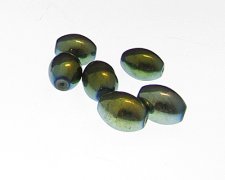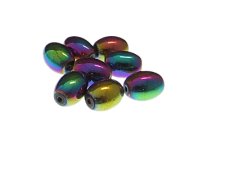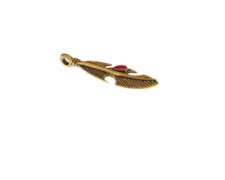Bead Threads and Cords
There is so much stringing media now available. In order to decided which string to use, you need to consider what you’re stringing; there is no one single type of string that can do it all. There are many types of threads and cords that are used for beading.
Beading threads are like very thin long ribbons, which are made up of long strands of fibers. They are typically waxed with beeswax to keep them from fraying. Threads, once waxed, are actually stronger and more durable than bead cords, but they are unsightly. Even if the product says it is pre-waxed, you should always wax these threads. They are meant to be fully covered with beads, thus hidden within your pieces. Threads are used in both bead weaving and bead stringing projects. Beading threads (example: Nymo, Silamide, Kevlar, and C-Lon, FireLine, PowerPro and C-Thru) are used like threads, but they are really a hybrid between threads and cable wires. These are threads that are braided together and encased in a nylon coating (cable wires are wires that are braided together and encased in nylon). You don't have to wax these. These hybrid cable threads are not meant to show in your piece. If you want the stringing material to show in your piece, you would typically use what is called a bead cord.
Beading cords are threads that are braided together, to make them visually attractive. You don't wax bead cords, so bead cords will have problems of fraying and stretching that waxed threads will not. Beading cord is available in several different fibers including elastic, nylon, satin, silk or other natural fibers. Cord can be used for its appearance, durability or suppleness, depending on the type of beading project you’re planning. Bead cords are used for projects where you want the cord to show, like putting knots between beads, or for necklaces where you have a cluster of beads, then a length of cord showing, and then another cluster of beads, then the cord.
Silk is most often used for pearls, because it is a higher quality thread than nylon. So, when you’re charging people to hand-knot their pearl strands, it only makes sense to use a good quality thread. You can purchase silk on large spools or on cards with attached twisted needles. It also comes in a variety of colors and sizes.
Nylon is used when knotting long, stone bead necklaces. It can be purchased on long rolls or on cards with attached needles. Since nylon is a synthetic fiber, it doesn’t stretch or fray. Nylon also comes in different colors and sizes.
Monofilament is often labeled as Jewelry Thread, but it's actually fishing line. It is very strong and can be used for beading. It comes in various thicknesses, colors and weights. Fishing line is very cheap and should not be used when making an expensive piece of jewelry, or one for sale.
Nymo is used mostly for seed beads. It comes in a range of colors and various sizes. You can buy it on large rolls or tiny bobbin sized rolls. It must be waxed using either beeswax or a product called Thread Heaven. It is a non-twisted fiber, which is easy to thread and fairly strong.
Silamide is an all purpose beading thread also used with seed beads. It is pre-waxed with strands twisted together, so it is convenient and strong. It now is available in all kinds of colors.
Coated Wire has some of the best products in recent development for bead stringing. Depending on the manufacturer, there are various sizes and colors available. This cord works great with crystals, all types of stone beads and even the thinner sizes can be used with some pearls.
Tiger-tail is a nylon coated wire cable, which is very strong and stiff since it consists of a number of strands of thin steel wire. This wire makes a great choice for bead stringing; you can easily tie knots with it. The wire also comes in many varying sizes or gauges depending on the weight and type of beads you are using.
Leather Cord is great to use for heavy necklaces. It is also attractive enough to be incorporated into part of the bead design with out having to worry about covering it up with beads. It comes in different sizes and all kinds of colors. It gives a natural, authentic look to a piece of jewelry.
Hemp also works nicely with large beads and the colors can be coordinated well with polymer clay beads. This is also good to use with macrame and is pretty strong.
Waxed Linen Cord is often used with macrame designs too. It doesn’t come in a huge assortment of colors and most often will bfound only in black or brown, but it is pretty strong because it’s waxed. If you want to make long necklaces with heavy beads, this would be a cord to consider.
Kevlar is strong and durable, and often used in seed beads when weight is a consideration. It is very thin, but only comes in a few colors. It is the thread used to make bullet-proof vests. It is not recommend it for use in beaded jewelry because the thread tends to breakdown when exposed to skin and it does not knot well either. Beaders tend to use this thread mainly for bead appliqué that does not involve direct skin contact, such as an appliqué on a purse. It is also often used for tapestries but said tapestries should not be hung in direct sunlight.
Stretchy Cord / Elastic is another great stringing material, especially if you do not want to use clasps. Stretchy cord is thin and flexible enough to stretch over your wrist for a bracelet and even your ankle for an ankle bracelet. The ends tie easily and are fairly easy to hide. Stretch cord is also great to use when you create a gift for a child, as there are no complicated clasps to fasten. Stretchy cord is also a great first beading medium if one is interested in learning how to string beads.
100% Polyester Thread is a great choice for bead crochet. This thread makes lovely soft crochet ropes. It is strong, difficult to break, and comes in a variety of colors. It does not break easily or mildew, and is therefore a good choice for warping a beading loom.








